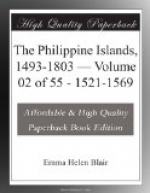[48] See the notarial attestation of the taking of possession of Barbudos in Col. doc. ined. Ultramar, iii, pp. 76-79. This was apparently one of the Marshall Islands.
[49] On January 26, 1565, Legazpi in person took possession of the Ladrones, for the Spanish crown. This possession was made in the island of Guam, before Hernando Riquel, government notary, and with all the necessary formalities. The witnesses were “Fray Andres de Urdaneta, prior; the master-of-camp, Mateo del Sanz; the accountant, Andres Cauchela; the factor, Andres de Mirandaola; the chief ensign, Andres de Ybarra; Geronimo de Moncon, and many others.” See the record of possession, Col. doc. ined. Ultramar, iii, pp. 79-81.
[50] Cf. with this the thievishness, and dexterity therein, of the Huron Indians, in Jesuit Relations (Cleveland reissue), v, pp. 123, 241, 243, and elsewhere.
[51] This island is styled variously Guam, Goam, Guan, and Boan (see Col. doc. ined. Ultramar, ii, p. 243). The United States government now uses it as a coaling station.
[52] From an official document drawn up by Hernando Riquel, it appears that the fleet reached the Philippines in very poor condition, due to insufficient and careless preparation. In response to a petition signed by the royal officials “Guido de la Vacares [Lavezaris], Andres Cauchela, and Andres de Mirandaola,” that testimonies be received from certain officers and pilots of the fleet, in regard to its poor condition, Legazpi ordered such depositions to be taken, which was done on May 23, 1565. These testimonies show that the fleet left Puerto de la Navidad with insufficient crews, marine equipment, artillery, and food, in consequence of which great sufferings had been and were still being endured. It was testified “that the provisions of meat, lard, cheese, beans and peas, and fish lasted but a short time, because of putrefying and spoiling by reason of having been laid in many days before sailing.” See Col. doc. ined. Ultramar, iii, pp. 305-318.
[53] The notarial testimony of this taking of possession will be given in this volume, p. 167.
[54] Probably the island of Leyte. See Col. doc. ined. Ultramar, ii, p. 258.
[55] This ceremony of blood friendship will be explained in later documents. It was characteristic of Malayan peoples. The present Cabalian is in the extreme S.E. part of Leyte.




